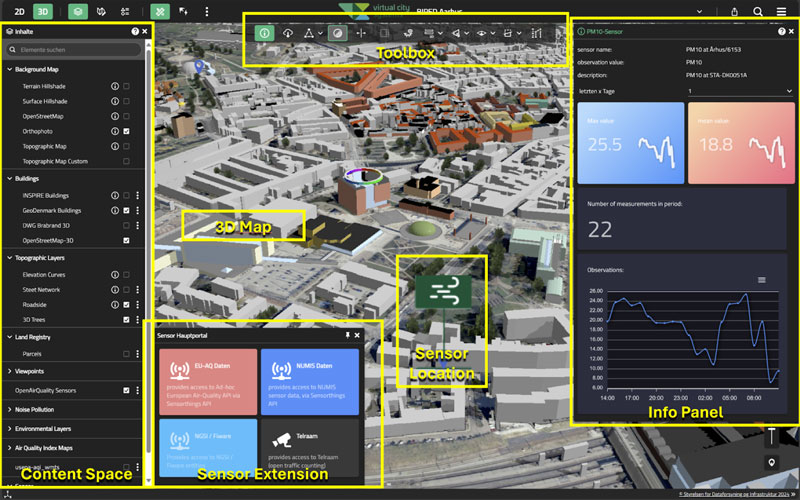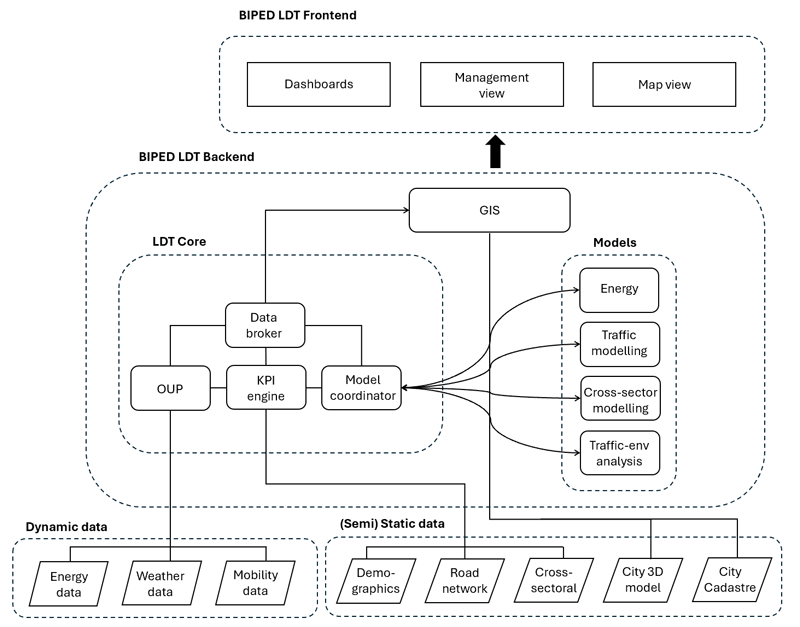by Pavel Kogut (Digital Resilience Institute), Eva Schmitz (Data Competence Center for Cities and Regions), and Arne Schilling (Virtual City Systems)
Positive Energy Districts (PEDs) are a key building block in the future energy paradigm for carbon-neutral cities and communities. With digital twin technology, urban stakeholders can take advantage of smart planning and control measures to optimise PED development. A new PED-oriented digital twin that covers more domains than just energy is currently being created for Aarhus to fast-track its balanced transition to net zero.
PEDs produce more energy than they consume during a year, an outcome they achieve by implementing energy efficiency innovations and tapping into locally sourced renewables [1]. With the rise of modern technology, PED development is set to evolve towards a more agile arrangement in which decisions are first tested and fine-tuned in virtual environments prior to the on-the-ground deployment. An example would be a district heating system with a substantial renewables component that needs to handle peak loads during extreme weather conditions. Using a mix of consumption data and weather forecasts (temperature, wind, precipitation), the operator can model demand spikes and implement strategies to optimise a heating plant’s load performance [2]. A key enabler of this virtual prototyping is Local Digital Twins (LDTs), a technology platform that combines static and dynamic data with simulation models to create a digital representation of a functional area.
However, current LDT implementations lack the sophistication necessary to characterise PEDs in all their complexity. Focusing on a limited number of urban systems in PED modelling will not do justice to the wider urban fabric without which no PED representation (and its development for that matter) can be considered complete. In order to overcome this shortcoming, a multi-dimensional LDT has been developed for the Brabrand district of Aarhus, Denmark. Called BIPED [L1], the solution integrates, in addition to energy and mobility, cross-sectoral “soft data” on Brabrand’s social dimension and the environment to provide a more holistic PED twin that better represents physical reality.
Modelling scenarios
Relevant datasets and variables for PEDs are those used to construct its energy profile (district heating, energy consumption), mobility profile (road network, traffic flows), socio-environmental profile (demographics, perceptions of happiness and safety, green spaces, weather) as well as the 3D model of a district (based on remote sensing data) . To ensure accuracy and adoption by local stakeholders, models are calibrated by aligning them with real-world measurements. In the next step, models are brought to bear in getting actionable insights to end users, with measures being controlled in user-specific frontends (Figure 1). A key activity here revolves around what-if scenarios aimed at predicting system behaviour in response to specific interventions or unforeseen events.

Figure 1: BIPED user interface in VC Map.
Although PEDs focus on energy, ultimately they are about ensuring wellbeing and sustainability through an ambitious district transformation, and this requires taking the wider urban context into account. Besides strictly energy-related scenarios for district heating, for example, LDTs for PEDs should support simulations that cover additional domains affected by green policies.
LEZ impact
Low emission zones are intended to make urban environments healthier by reducing car traffic. An LDT can predict changes in traffic, estimate the resulting decrease in energy consumption, and calculate the potential reduction of air pollution in affected districts. Policy makers can use simulated results to examine trade-offs between expected benefits and drawbacks e.g. pollution displacement, increased travel times.
Road safety
As cities are being redeveloped to create more sustainable urban environments, one of the expected co-benefits is improved road safety. In this context, a multi-dimensional analysis of traffic accidents can guide the design and evaluation of urban policies to ensure that car-free city centres, cycling paths, micro-mobility and other green measures result in less accidents/injuries, not more.
Traffic
A cross-domain LDT with a two-way synchronisation to the real world can assess the likelihood of traffic build-up caused by roadworks, bad weather or an accident and inform drivers accordingly using messaging signs or app. In a scenario where a large influx of electric vehicles is expected, the road twin of an LDT can signal this prediction to its energy counterpart so that energy can be channelled from quieter places to meet increased demand.
Technical architecture
Given the need to integrate multiple components that can function independently, are easily manageable and scalable, a modular structure has been adopted for BIPED’s architecture (Figure 2). In the LDT backend, the Core ingests and processes dynamic data (through the Open Urban Platform) and semi-static data (through the KPI Engine). The 3D model of a city comprising satellite imagery and building shapes is not funnelled through the Core to avoid unnecessary overload, and instead connects directly to the GIS publisher. The Core’s Model Coordinator provides the necessary data to the models and stores simulation results for later use. The models leverage multi-source data to forecast energy demand, simulate traffic what-if scenarios, perform environmental analysis, emotional mapping, and more. The Data Broker provides data and metadata in a coherent bundle using standardised data structures and programmatic interfaces. Finally, all the necessary user interfaces (3D map, dashboards, management view) are provided through the frontend to enable data exploration and analysis, as well as system management.

Figure 2: BIPED LDT architecture.
By structuring LDT in modular units, developers can isolate and address specific functionalities without impacting the entire twin. Concurrent development can proceed without undermining the ability to troubleshoot, upgrade and optimise individual components as necessary. Furthermore, modularity facilitates the integration of new features and technologies, making it possible for BIPED to adapt to evolving user requirements.
This article is part of a project that has received funding from the European Union’s Horizon Europe research and innovation programme under the Grant Agreement 101139060.
Link:
[L1] https://www.bi-ped.eu/
References:
[1] R. Hinterberger et al., “White paper on PED reference framework for positive energy districts and neighbourhoods,” JPI Urban Europe, 2020. https://jpi-urbaneurope.eu/ped/
[2] H. Li, S. J. Wang, “Load management in district heating operation,” Energy Procedia, vol. 75, pp. 1202–1207, 2015. https://doi.org/10.1016/j.egypro.2015.07.155
Please contact:
Pavel Kogut, Digital Resilience Institute, Czechia











